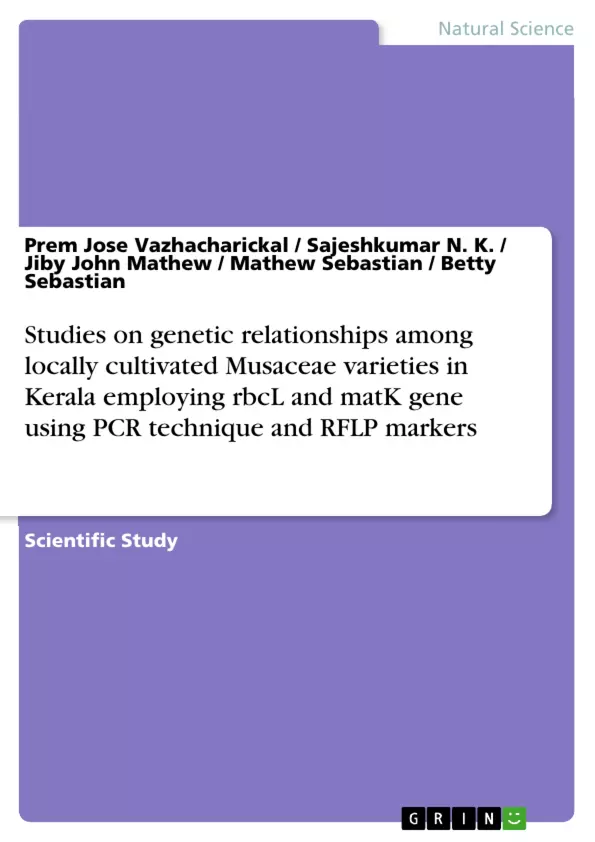The classification of the Musaceae (banana) family species and their phylogenetic inter-relationships remain controversial, in part due to limited nucleotide information to complement the morphological and physiological characters. In this work the phylogenetic relationships within the Musaceae family were studied locally using 3 species. DNA sequences obtained from nine unlinked nuclear genes. Musa species grow in a wide range of environments and have varied human uses, ranging from the edible bananas and plantains of the tropics to cold-hardy fibre and ornamental plants. There are five taxonomic sections in the genus Musa, two of which contain edible bananas. For studying phylogeny of locally collected Musaceae (banana) family varieties using rbcL gene and matK gene. For this study DNA was extracted by using CTAB method. This extracted DNA was analysed by spectrophotometry method for checking purity of DNA. The samples were gel electrophoresed by 1% agarose gel electrophoresis at 80 volts. After electrophoresis the gel is examined in gel documentation system. The DNA band was observed under UV light looking florescent orange red colour. The extracted DNA was amplified by PCR method and PCR sample was applied for electrophoresis for checking DNA bands. After all this analysis PCR sample send for DNA sequencing for checking the nucleotide. Comparing the sequenced nucleotide for checking phylogeny of locally collected banana varieties. The locally collected gene sequence-based phylogeny presented here provides support for the early studies of speciation within the Musaceae. An understanding of the main phylogenetic relationships between banana species will help to fine-tune the taxonomy of Musaceae.
Inhaltsverzeichnis (Table of Contents)
- Abstract
- 1. Introduction
- 1.1 Objectives
- 1.2 Objectives of the study.
- 1.3 Taxonomical classification
- 2. Review of literature........
- 2.1 Uses and importance
- 2.2 Banana stem and flower
- 2.3 Banana Leaves:
- 2.4 Environmental status:.
- 2.5 Molecular markers..........\li>
- 3. Hypothesis ....
- 4. Materials and Methods
- 4.1 Study area......
- 4.2 Sample collection.
- 4.3 Description of the species ....
- 4.4 Species identification
- 4.3 Isolation of DNA..
- 4.5 Quantification of DNA.....
- 4.6 PCR primers
- 4.7 PCR amplification.......
- 4.8 Data sequencing.
- 4.9 Data analysis
- 4.11 Statistical analysis
- 5. Results and discussion......
- 5.1 BLAST search for rbcL: sample A; Palayankodan
- 5.2 BLAST search for rbcL: sample B; Njalipoovan.
- 5.3 BLAST search for rbcL: sample C; Robusta
- 5.4 BLAST search for matK: sample A; Palayankodan ......
- 5.5 BLAST search for matK: sample B; Njalipoovan.......
- 5.6 BLAST search for matk: sample C; Robusta .....
- 5.7 Multiple sequence alignment for partial rbcL gene for Musaceae.
- 5.8 Multiple sequence alignment for partial matk gene for Musaceae.
- 5.9 Phylogenetic tree based on partial sequence rbcL gene by UPGMA method ......
- 5.10 Phylogenetic tree based on partial sequence rbcL gene by Maximum likelihood method......
- 5.11 Calculation of genetic distance using rbcL gene....
- 5.12 Phylogenetic tree based on partial sequence matk gene by UPGMA method ..
- 5.13 Phylogenetic tree based on partial sequence matk gene by Maximum likelihood method.......
- 5.14 Calculation of genetic distance using matk gene......
- 6. Conclusions...
- Acknowledgements
- References..
Zielsetzung und Themenschwerpunkte (Objectives and Key Themes)
This study aims to investigate the genetic relationships among locally cultivated Musaceae varieties in Kerala, India, utilizing the rbcL and matK genes. The study employs PCR techniques and RFLP markers to explore the genetic diversity and evolutionary connections within these varieties.
- Genetic relationships among Musaceae varieties in Kerala
- Application of PCR technique and RFLP markers
- Analysis of rbcL and matK genes for genetic diversity
- Phylogenetic relationships among Musaceae varieties
- Contribution to the understanding of Musaceae evolution in Kerala
Zusammenfassung der Kapitel (Chapter Summaries)
The introduction provides an overview of the study's objectives, including the importance of Musaceae in Kerala's agricultural landscape and the use of molecular markers for genetic diversity analysis. Chapter 2 delves into the diverse uses and importance of Musaceae, exploring their economic, cultural, and environmental significance. The materials and methods section outlines the specific techniques employed for DNA isolation, PCR amplification, sequencing, and phylogenetic analysis. This chapter details the study's methodology for examining the genetic relationships among Musaceae varieties. Results and discussion analyze the data obtained from the study, focusing on the phylogenetic relationships revealed by the rbcL and matK genes. The chapter includes detailed information about the genetic diversity within the collected Musaceae samples.
Schlüsselwörter (Keywords)
Musaceae, Kerala, genetic relationships, rbcL gene, matK gene, PCR, RFLP, phylogenetic analysis, genetic diversity, molecular markers, banana varieties.
- Arbeit zitieren
- Dr. Prem Jose Vazhacharickal (Autor:in), Sajeshkumar N. K. (Autor:in), Jiby John Mathew (Autor:in), Mathew Sebastian (Autor:in), Betty Sebastian (Autor:in), 2016, Studies on genetic relationships among locally cultivated Musaceae varieties in Kerala employing rbcL and matK gene using PCR technique and RFLP markers, München, GRIN Verlag, https://www.grin.com/document/370768



